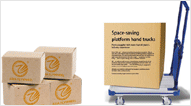Selecting the correct caster for your application is very important. If you do not select the correct caster, you or the users of your equipment could be injured. If you are not absolutely certain which caster is the correct one for your use, contact a safety or engineering consultant who knows your equipment and its intended use to assist you.
IntroductionCasters and wheels are offered in a wide variety of sizes and types. Although there is no simple formula to follow in choosing the proper caster or wheel, the information shown below and on the following pages is intended as a guide to assist you in specifying, operating and maintaining casters for safety and maximum life. Please read this information carefully.
Load Weight & Wheel SizeThe first consideration for caster selection is to determine the combined weight of the equipment and maximum load on this equipment. Generally, the greater the weight, the larger the wheel required for the caster. Larger wheels distribute weight and roll more easily over floor obstructions.
To determine the load capacity for each caster, divide the combined weight of the equipment and maximum load by the number of casters to be used. This is the load that each caster and wheel must support. Always select a caster and wheel that are rated for a capacity greater than the calculated load per caster. This allows for unusual conditions that could change the performance of the caster.
Wheel ChoicesAs a general rule, hard tread wheels perform better on soft or smooth floors and soft tread wheels roll better on hard or rough floors including outdoor surfaces. When choosing a wheel type, take into consideration all special floor conditions– tracks, gutters, grates, sills, elevator thresholds, seams and dock plates. The larger and softer the wheel, the greater the ability to roll over rails and similar obstacles.
To protect floors from damage, choose softer cushion tread wheels. Solid Cushion Rubber, Advantage ™ TPR (thermoplastic rubber), High Modulus Rubber and Pneumatic Rubber wheels will provide quiet operation and maximum floor protection. Steel and Cast Iron wheels are not recommended for floor protection, but they are well suited for industrial applications.
Polyurethane wheels like cast iron polyurethane wheels are frequently an effective compromise giving moderate floor protection with greater load capacity.
Wheel BearingsWheel bearing bore riding directly on the spanner bushing and/or axle.
Recommended for loads where maximum rolling ease is required. They require less effort to start rolling and keep rolling than other bearing types.
This bearing carries greater loads than same size ball bearing. Well suited for heavier, industrial uses.
Delrin® Bearing
An economical bearing well suited to conditions of frequent exposure to water, steam cleaning, salts, brine and corrosive conditions.
Often unusual operating conditions require selection of casters and wheels with special features. Listed below are several guidelines for selecting casters for special conditions:
• The presence of acids, oils or corrosive chemicals require wheels made of polyurethane, phenolic, polyolefin or steel.
• Extreme temperatures require special bearing lubricants or plain bore bearings.
• Never use rubber tread wheels in corrosive environments.
• In hospitals, bakeries and food processing plants where cart washings are required, select nickel-plated casters with raceway grease seals and zerk grease fittings.
• For very frequent wash down applications or wet environments, specify stainless steel casters.
• In textile plants and laundries, specify casters with thread guards to reduce the collection of thread, string and general floor debris.
• For office machines such as copiers which require a low load height, choose Flywheel business machine casters and low profile casters.


